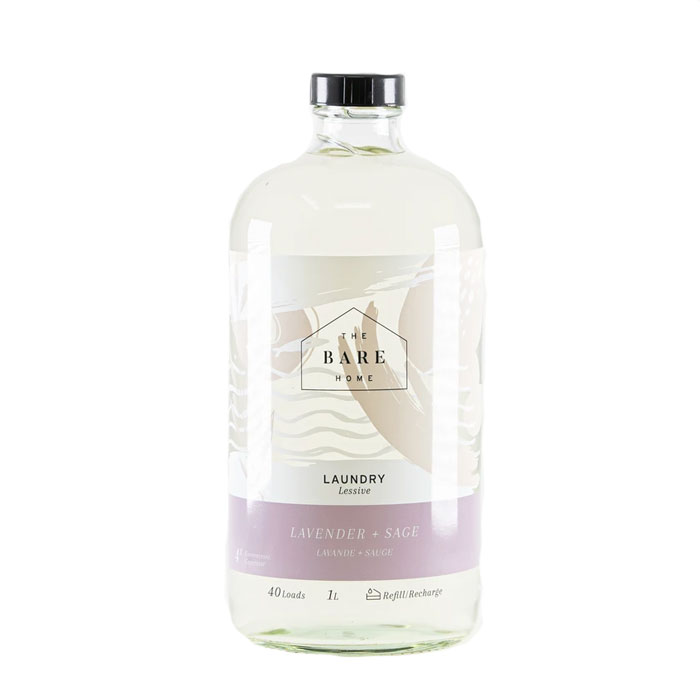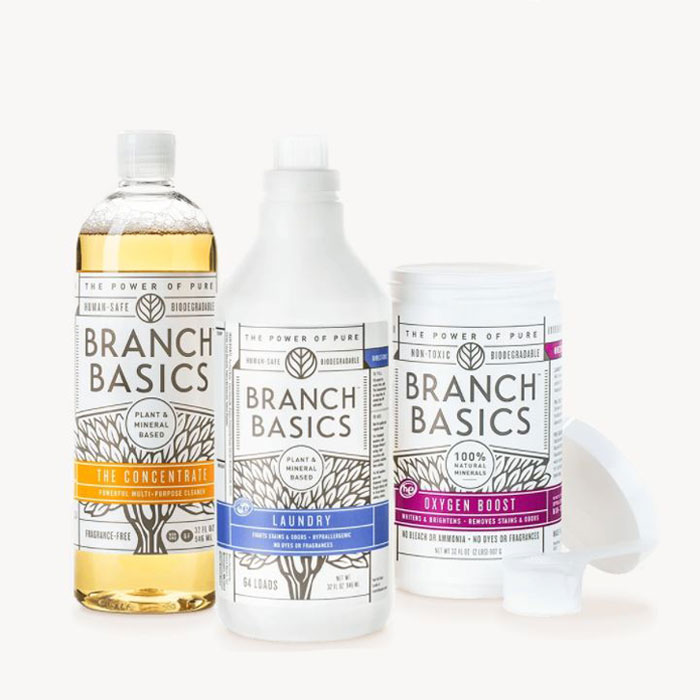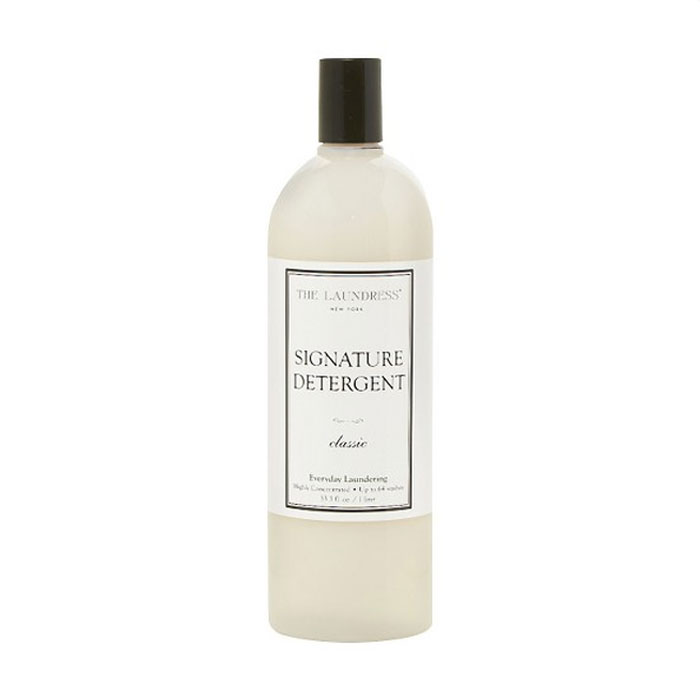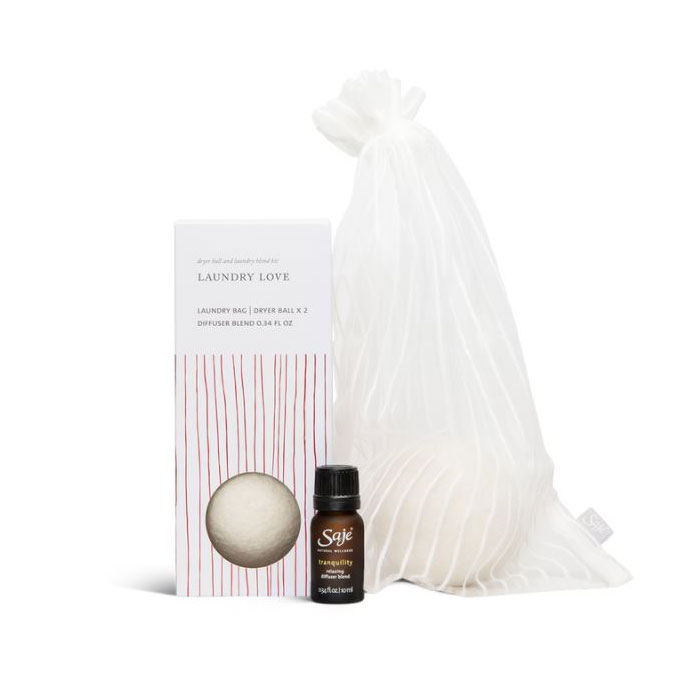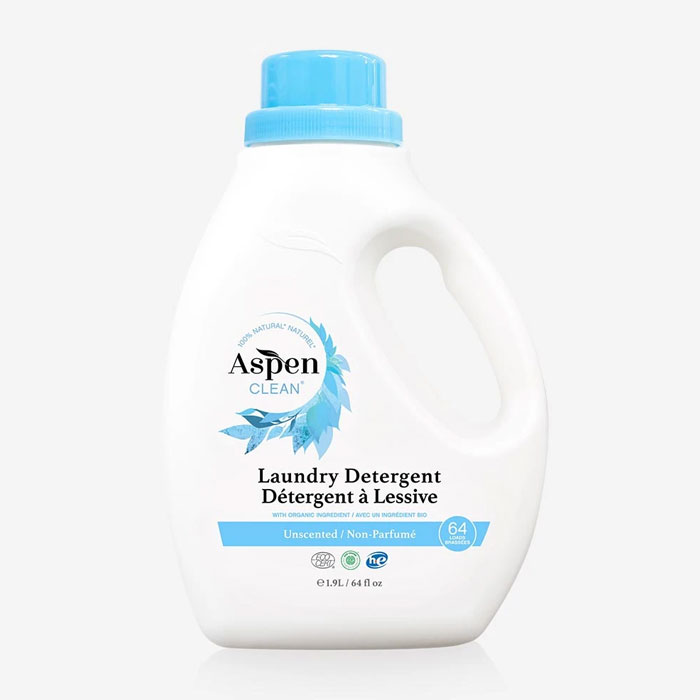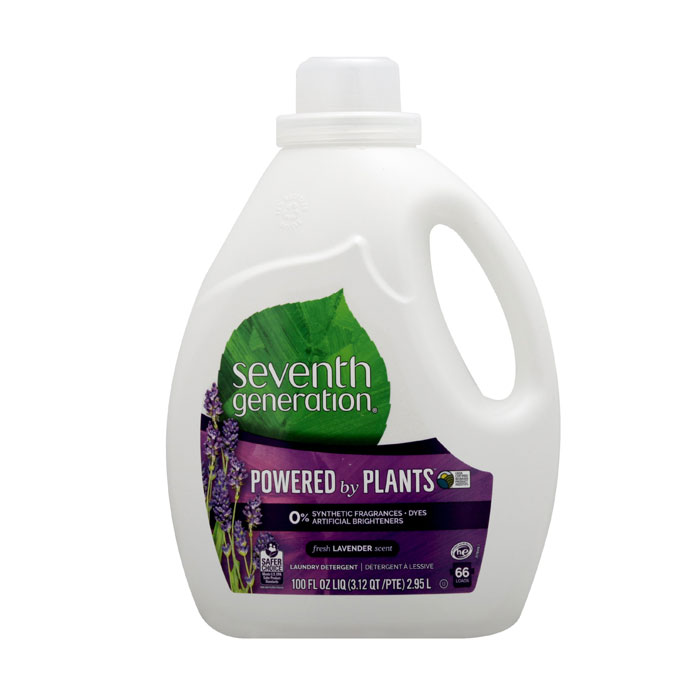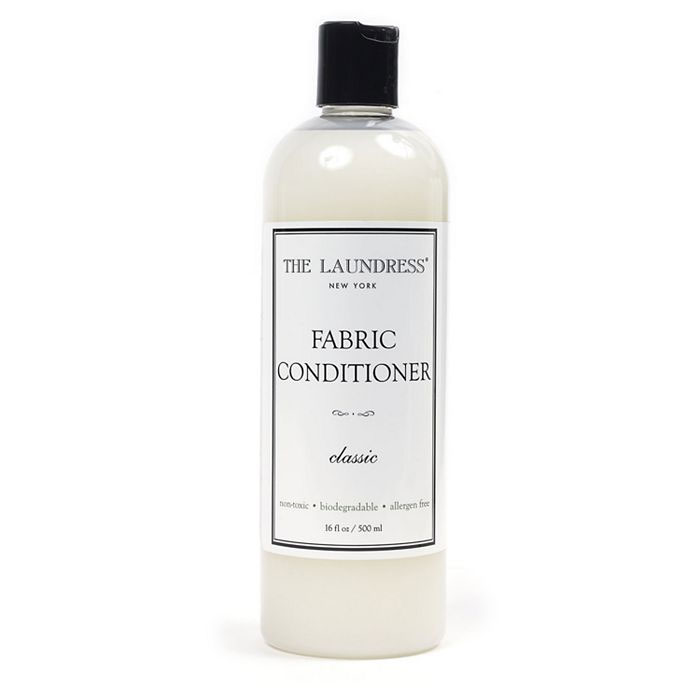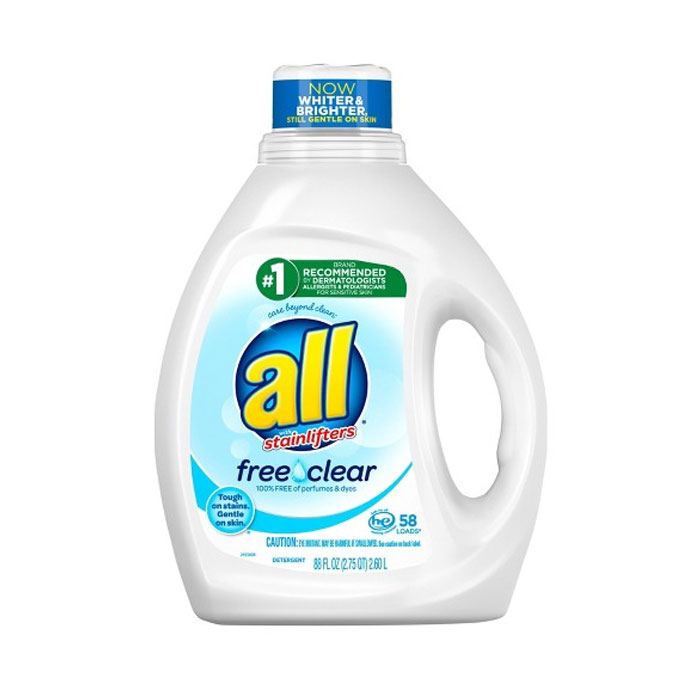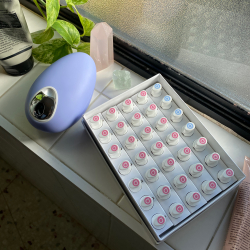
Chronic Skin Irritation? Your Laundry Detergent Might Be to Blame
How your laundry products could be affecting your skin.
Whenever we exhibit signs of skin irritation, we begin assessing what’s new in our routine—that body wash we just bought, the foods we recently introduced to our diet, that necklace we were gifted—but how likely are we to conclude that the laundry detergent we started using might be to blame? From foaming agents to preservatives, fragrances and dyes, our laundry products can be laden with dozens of harmful chemicals and allergens. We asked the pros how they might be affecting our skin and what we can do about it. Plus, learn which skin-friendly alternatives you should consider to update your laundry-day routine.
How the Skin Can React
When our skin comes into contact with something it doesn’t like, our immune system responds, causing a reaction that might present as red, itchy, or painful. This is known as contact dermatitis and suggests you have recently interacted with an allergen or irritant. And considering that we wash everything from our clothes to our sheets and towels, the potential for some form of discomfort from your laundry products is high.
“Most commonly, an allergic reaction or sensitivity to laundry products will appear as redness with a sensation of itch,” says Dr. Robyn Gmyrek, board-certified dermatologist at Park View Laser Dermatology. According to Dr. Gmyrek, contact dermatitis can be mild or severe and lead to swelling, depending on how much of an immune reaction the body makes. “If enough swelling or inflammation is present, blisters may appear on the skin,” she adds, equating the presentation to that of a poison-ivy allergy and adding that many people report experiencing a burning sensation on the skin, as well.
While contact dermatitis can develop anywhere on the body, Dr. Gmyrek notes that the parts of the body with thinner skin, such as the face, eyes, and genital area, are more susceptible and that the swelling may be more extensive in these areas. She cites that the underarms might be the first to feel itchy and show signs of redness and irritation due to extensive and prolonged contact with clothing. “As a basic rule, any areas with longer periods of contact to the irritant will have more reaction,” she says. “For example, if the pillowcase has the detergent allergen or irritant and you are a side sleeper, that side of the face will have more reaction.”
Dr. Pamela Scheinman, director of the contact dermatitis and occupational dermatology program at Brigham and Women’s Hospital, adds, “Often areas of pressure, friction, heat, and humidity can be most affected by contact dermatitis,” and that areas such as the flexures of the arms and legs and groin creases can be commonly affected.
Dermatologists agree that anyone can experience skin irritation to allergens or irritants in laundry products; however, “those with a previous history of skin allergies or baseline skin issues such as eczema or psoriasis—conditions that disturb the integrity of the normal skin barrier—could be more sensitive to allergens and irritants in laundry products,” says Dr. Scheinman.
It’s worth noting that chronic skin inflammation, regardless of how mild it may be, shouldn’t be ignored. As Dr. Scheinman points out, chronic skin inflammation with subsequent scratching can cause thickening of the skin, pigmentary changes, and sometimes scarring. “There is a theoretical concern that with chronic allergic stimulation, it might predispose to developing abnormal T-cells proliferating in the skin,” she says. She further adds that if patients require chronic topical steroid medications to control their symptoms, these steroids can thin the skin, cause dilated blood vessels and decreasing local immunity. Additionally, Dr. Scheinman highlights that environmental factors “such as forced hot air and decreased ambient humidity can dry the skin, leading to a decreased skin barrier, allowing allergens to penetrate the skin and be presented more readily to the immune system.”
Common Culprits in Your Products
FRAGRANCES: When it comes to our laundry, brands have taught us to associate the cleanliness of our clothes not by how clean they look, but how clean they smell. While that “April fresh” scent lingering in our fabrics might seem pleasant enough, it can trigger adverse reactions on our skin. By exploiting our desire for fresh-smelling clothes, laundry brands are taking scent staying power to excessive extremes, with scent boosters sometimes boasting 12 (yes, 12!) weeks of freshness and detergents proclaiming you’ll be the “subject of random sniffings.” It comes as no surprise, then, that Dr. Scheinman and Dr. Gmyrek agree fragrances are among the most common culprits causing skin irritation. A recent study on the prevalence of fragrance sensitivity found that just shy of 30 percent of US participants experienced adverse effects to the skin at the hands of scented laundry products.
PRESERVATIVES: Another likely culprit is preservatives, listed alongside fragrances and metals by the Cleveland Clinic as primary causes of contact dermatitis. More specifically, Dr. Scheinman highlights Methylisothiazolinone (MI) as a prime suspect, a synthetic chemical used as a preservative in consumer products for its antimicrobial properties, explaining that it’s the second-most common allergen in North America.
SURFACTANTS: Dr. Gmyrek also calls out surface-active agents (surfactants), a category of chemical in which you will find sodium lauryl sulfate (SLS), another common culprit. A foaming agent used in detergents and other cleaning products to remove dirt, surfactants are known to negatively interact with skin and cause reactions in people with sensitive skin. According to a study on laundry detergents and skin irritancy, surfactants are categorized into five types, with anionic and cationic having the highest irritancy potential. By contrast, nonionic surfactants are mild on the skin and effective at removing oil-based stains. When anionic and nonionic surfactants are mixed, the result is reduced skin irritancy potential. The same study concludes that on average, 2.5 percent of the detergent we use remains on fabric after washing and two rinse cycles, and that anionic surfactants form a higher amount of detergent residue.
Dr. Scheinman adds that other, less common allergens in laundry detergents include coconut derivatives and propylene glycol.
Determining If Your Detergent Is to Blame
“It can be difficult,” says Dr. Gmyrek in regard to identifying your laundry products as the culprit, adding that “when it comes to contact dermatitis, one must evaluate what topical medications, foods, supplements, lotions, detergents, or fragrances have come in contact with your skin in the past two or three days.” This exposure history, combined with a corresponding location on the body where the rash is seen, can be the key to determining if detergent is, in fact, to blame. Dr. Scheinman notes that “a simple test would be to swap out your laundry detergent with one that is free of dyes and fragrances,” adding that “if the previous skin eruption resolves with this easy remedy, one can infer that the detergent may have been problematic.” According to both dermatologists, the only way to definitively determine the source is to perform what is called a “patch test.” “This is done by a dermatologist or allergist to determine which specific chemicals you are allergic to in the product,” says Dr. Gmyrek.
Treating an Active Reaction
Treatment options can vary depending on the severity of the skin eruption and the discomfort it causes. To treat and soothe mild skin irritation, Dr. Scheinman recommends 100 percent petroleum jelly as a preservative-free, fragrance-free treatment. For skin irritation that is more troublesome, Dr. Gmyrek recommends a topical steroid cream to decrease inflammation, or an over-the-counter 1 percent hydrocortisone cream or ointment, applying it liberally two to three times per day for three to five days. She stresses the importance of avoiding the eye area, as hydrocortisone creams can cause glaucoma. Both dermatologists agree that over-the-counter, non-sedating antihistamines can be helpful if there is a lot of associated itching and no contraindications to these medications. “If patients are still very uncomfortable after exhausting these treatment options, stronger prescription-strength topical steroid medications can be prescribed by a doctor,” says Dr. Scheinman.
Skin-Friendly Solutions
Since we now know that detergent residue can remain on our clothes after washing, Dr. Gmyrek suggests a double rinse cycle for your clothes. “I also recommend being very careful about the amount of detergent you use to launder your clothes, especially with the high-efficiency washers which have been designed to use less water,” says Dr. Gmyrek. Avoid free-pouring and only use the amount needed for the size of the load.
“I first recommend that my patients switch to a detergent that is free of dye and perfume,” says Dr. Scheinman. “If people are still having difficulties after that, they can look for non-detergent products that do not contain fragrance, dyes, coconut, propylene glycol, or methylisothiazolinone.” To help you identify what is, or more important, what isn’t in the products you use, an app such as Think Dirty can be a helpful resource in identifying potential toxins in household, personal care, and beauty products. A simple scan of a barcode will assess the overall risk of a given product based on the potential health impacts of its published ingredients.
If you find yourself struggling with skin sensitivity at the hands of your laundry products, consider these skin-friendly swaps:
Dropps Sensitive Skin & Baby Detergent
$24
Gentle yet powerful at getting your fabrics clean, this formula is free of fragrances, dyes, enzymes, phosphates, phthalates, parabens, and optical brighteners. Zero. Zilch. Nada. You can also feel good about the fact that the packaging is compostable and the shipping is 100 percent carbon neutral.
The Bare Home Lavender + Sage Detergent
$20
The ethos behind The Bare Home is to offer household products you can feel good about, products that are safe for you, your home, and the earth. This concentrated formula is hypoallergenic, phosphate free, dye free, and scented with essential oils of lavender and sage.
Branch Basics Laundry Kit
$59
Helping you toss the toxins, these products are plant- and natural-based, fragrance free, and without any harmful preservatives. This laundry kit includes a concentrate liquid for 64 loads, a bleach-free, ammonia-free oxygen boost, and a plastic laundry bottle.
The Laundress Signature Detergent
$21
Formulated with plant-derived anionic and nonionic surfactants, mineral-derived cleaning enhancers, and essential oils, this detergent is a great ammonia-, fragrance-, dye-, and formaldehyde-free alternative.
Saje Laundry Love
$24
Ditch the excessively scented dryer sheets in favor of wool dryer balls and an essential oil blend. Made from ethically sourced, cruelty-free New Zealand wool, these dryer balls also reduce drying time and static cling.
Aspen Clean Natural Laundry Detergent
$22
Fragrance free and made with plant and mineral-derived ingredients, no harmful chemicals or toxins will be left behind in your clothes to irritate your skin. This unscented detergent is ideal for those with allergies and sensitive skin.
Seventh Generation Laundry Detergent
$15
Made with 97 percent plant-based ingredients, this liquid formula is non-irritating with no dyes, optical brighteners, or synthetic fragrances.
The Laundress Fabric Conditioner
$18
Ditch the Downy in favor of this gentle plant-derived fabric softener. It is designed to decrease drying time, reduce wrinkling, and ease ironing while eliminating static cling. It’s also free of petroleum, phosphate, phthalates, and artificial color.
All Liquid Laundry Detergent, Free Clear for Sensitive Skin
$7
This dermatologist-recommended detergent is 100 percent perfume free and dye free and is an economical alternative that you can find easily at most stores.
Want more stories like this?
This Clean, Textured Hair Care Brand Caught the Eye of Issa Rae—She’s Now Co-Owner
6 Tastemakers on the Small Businesses They’re Supporting This Holiday Season
5 Ways to Have the Perfect Winter Saturday






